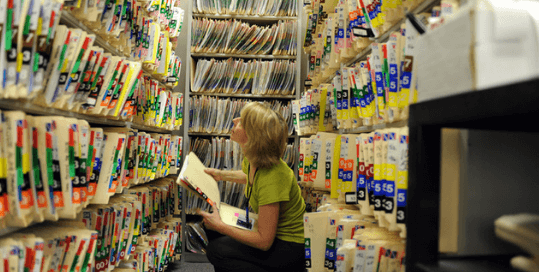What to do With Paper Patient Charts When Transitioning to Electronic Medical Records

As Doctors across the country transition to Electronic Medical Record Systems, they’re confronted with a major decision, what do I do with my paper charts? Practices and Doctors have a few options to choose from:
- Continue to use the paper chart for all patient visits.
Yes, Practices have the option to not implement an Electronic Medical Record System and continue to use paper charts like they always have. Financially is it the best option? It depends on how much of a penalty the practice will have to pay. Will operations and efficiency change? Maybe, they will probably remain the same but eventually start to decline.
With the volume of patients increasing, and patients wanting instant access to their records and answers to medical questions, patient satisfaction may begin to slip and small problems of the past may become large problems in the future.
- Use both, the EMR for day forward patient visits and use the paper chart when reference to historical information before the EMR was implemented.
Most practices start the EMR transition with this option first, and it is a good way to ease into having electronic records. All important information is imported into the EMR (vaccines, allergies, some medical history, etc.) and the EMR is used on a day forward basis. If there is a specific piece of information that is not in the EMR during an office visit, the practice can locate the paper chart and reference that piece of information.
The practice will be electronic going forward, but they still will have the same issues with maintaining a paper medical record archive that they had previously. Time spent searching for charts, searching for misfiled charts, needing space to store and maintain a paper archive (paper charts need to be kept until the patient’s retention period is up, regardless of what information is on paper and what is in the EMR), and not finding charts.
This option is a good starting point, but with time, the practice should consider taking the active paper patient charts, scanning them, and uploading them into the EMR.
- Scan active patient charts and reference historical information as electronic images in the EMR. Store inactive patient charts and have the ability to scan these charts ‘on demand’ if/when a chart is needed.
This is the most cost effective approach to transition to an EMR, convert the paper medical records that are actively being used by the practice, while retaining the inactive paper charts physically. The inactive charts can be stored at the practice or at a record storage facility with the ability to pull, scan, and electronically send a requested chart on demand.
All active paper patient information is scanned and the images can be referenced either in the EMR, stored on the practices internal network, or a document management system outside of the EMR. The three options for viewing the electronic images can be chosen by practice, and all three are great ways to host, search, and retrieve scanned patient information.
For the inactive patient charts, (each practice has its own definition of active and inactive), it may not be finically possible to scan all their information. But, the records can be stored at a secure, offsite storage facility, and have a patient manifest created (Ex. Box 1 contains these 25 patients). A patient’s chart can be requested by the practice and scanned ‘on demand’ and the scanned patient chart can be delivered to the practice within a few hours or less.
This is the most cost effective option, to have active patient charts instantly accessible either in the EMR or an internal network and have inactive charts securely stored physically but can be electronically delivered when requested.
- Scan all charts into the EMR.
No office is 100% paperless, but this is as close as they can get. All patient charts are scanned and accessible within seconds and a few mouse clicks. This option requires the largest investment, but also provides the largest return.
There is no paper archive to manage and store, charts cannot be misfiled or lost, all charts can be found within seconds, and charts can be transferred to other practices instantaneously. Going forward, the practice can scan the small amount of paper it will receive from other practices, insurance companies, patients, etc.
Converting to an Electronic Medical Record System can be difficult, time consuming, and frustrating, but the records management part of the transition does not have to be.
